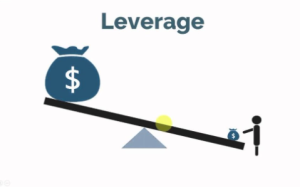Financial leverage is a powerful tool in the world of Forex that allows traders to execute larger trades with less capital. In other words, leverage acts like a loan that is provided by the broker to the trader to increase their buying power.
Imagine that you have 1000 dollars in your trading account. Without using leverage, you can only execute trades up to 1000 dollars. However, by using a leverage of 1:100, you can execute trades up to 100,000 dollars.
The advantage of leverage is that it allows you to earn larger profits from your trades. For example, if you trade with a leverage of 1:100 and the price of your chosen currency pair increases by 1%, you will make a profit of 1000 dollars, while without using leverage, your profit would only be 10 dollars.
However, financial leverage is like a double-edged sword. Just as it can increase your profit, it can also significantly increase your loss. In the example above, if the price of your chosen currency pair decreases by 1%, you will lose 1000 dollars, while without using leverage, your loss would only be 10 dollars.
Therefore, the use of financial leverage is associated with high risk, and before using it, you should be fully familiar with its advantages and disadvantages.
Example:
Suppose you believe that the price of the EUR/USD currency pair is increasing. You have 1000 dollars in your trading account and want to buy 10,000 euros. Without using margin trading, you would have to spend all of your 1000 dollars to buy 10,000 euros.
But by using margin trading with a ratio of 1:100, you only need 100 dollars (1% of 10,000 euros) as margin. The remaining 9900 dollars is provided to you as a loan by the broker.
If your prediction is correct and the price of EUR/USD increases, you can make a significant profit. For example, if the price of EUR/USD increases by only 1%, you will make a profit of 100 dollars (100% profit on your 100 dollar investment).
However, if your prediction is wrong and the price of EUR/USD decreases, you can incur a significant loss. In the example above, if the price of EUR/USD decreases by only 1%, you will lose 100 dollars (100% loss on your 100 dollar investment).
This example illustrates how margin trading can amplify both potential profits and losses, making it a powerful but risky tool in forex trading.

Types of Financial Leverage: Double-edged swords with a variety of blades!
As we said in the previous section, financial leverage is a powerful tool in the Forex world that allows traders to execute larger trades with less capital. But financial leverage has different types, each with its own advantages and disadvantages.
Here, we introduce three common types of financial leverage:
- Fixed Leverage:
Fixed leverage is like a double-edged sword with a fixed blade. In this type of leverage, the ratio of the loan to your investment remains constant. For example, if you use a leverage of 1:100, for every 1 dollar that you trade, the broker lends you another 99 dollars.
The advantage of fixed leverage is that you can accurately calculate the risk and reward of your trades.
But the disadvantage of fixed leverage is that it has less flexibility. For example, if you lose in a trade, you may have to close your trade early, even if you believe that the price will eventually change in your favor.
Example:
Suppose you are using a leverage of 1:100 and investing 1000 dollars in a trade. If the price of your chosen currency pair increases by 1%, you will make a profit of 100 dollars (10% profit on your 1000 dollar trade).
But if the price of your chosen currency pair decreases by 1%, you will lose 100 dollars (10% loss on your 1000 dollar trade).
- Variable Leverage:
Variable leverage is like a double-edged sword with a moving blade. In this type of leverage, the ratio of the loan to your investment can change over time.
The advantage of variable leverage is that it has more flexibility. For example, if you lose in a trade, you can reduce the leverage to prevent further losses.
But the disadvantage of variable leverage is that it is more difficult to calculate the risk and reward of trades.
Example:
Suppose you are using variable leverage and investing 1000 dollars in a trade. If the price of your chosen currency pair increases by 1%, you will make a profit of 100 dollars (10% profit on your 1000 dollar trade).
But if the price of your chosen currency pair decreases by 1%, your loss may be more than 100 dollars, because the leverage can increase during the trade.
- Combined Leverage:
Combined leverage is like a double-edged sword whose blade can be both fixed and variable. In this type of leverage, you can use a combination of fixed and variable leverage.
The advantage of combined leverage is that you can use the advantages of both fixed and variable leverage.
But the disadvantage of combined leverage is that it is more complex than the other two types of leverage.
Example:
Suppose you are using combined leverage and investing 1000 dollars in a trade. At the beginning of the trade, you use a leverage of 1:100. But if the price of your chosen currency pair decreases by 0.5%, the leverage is automatically reduced to 1:50 to prevent further losses.
Choosing the right type of leverage:
Choosing the right type of leverage depends on various factors such as your trading style, your risk tolerance, and your trading goals.
Calculating Financial Leverage: A Tool to Measure the Power of Your Trades
Financial leverage is a powerful tool in the Forex world that allows you to execute larger trades with less capital. In other words, leverage acts like a loan that is provided by the broker to the trader to increase their buying power.
Calculating financial leverage helps you accurately assess the risk and reward of your trades.
Here are two methods for calculating financial leverage:
- Simple Method:
Formula:
Leverage = Trade Volume / Margin
Example:
Suppose you want to buy 100,000 dollars worth of the EUR/USD currency pair.
Trade Volume: 100,000 dollars Margin: 10,000 dollars
Calculating Leverage:
Leverage = 100,000 / 10,000 = 10
Meaning:
With a leverage of 10, you can trade 10 times more than your capital, meaning 100,000 dollars worth of the EUR/USD currency pair with 10,000 dollars of capital!
- Advanced Method:
Formula:
Leverage = (Trade Volume / Your Share of the Trade) / (Your Share of the Trade / 1)
Example:
Suppose you want to buy 100,000 dollars worth of the EUR/USD currency pair and use a leverage of 1:100.
Trade Volume: 100,000 dollars Your Share of the Trade: 10,000 dollars
Calculating Leverage:
Leverage = (100,000 / 10,000) / (10,000 / 1) = 100
Meaning:
With a leverage of 1:100, you are covering 1% of the total trade with your capital (10,000 dollars) and the remaining 99% is financed by the broker’s loan.
Important Points:
- Always calculate the risk and reward of your trades accurately before using financial leverage.
- Use risk management strategies like stop-loss and take-profit to prevent large losses.
- Remember that financial leverage can act like a double-edged sword. It increases your profits and losses simultaneously.
Real Numerical Example:
Example:
Suppose you have 1000 dollars in your trading account and want to buy 10,000 dollars worth of the GBP/USD currency pair.
Trade Volume: 10,000 dollars Investment: 1,000 dollars
Calculating Leverage:
Leverage = 10,000 / 1,000 = 10
Meaning:
With a leverage of 10, you can trade 10 times more than your capital, meaning 10,000 dollars worth of the GBP/USD currency pair with 1,000 dollars of capital!
In this example, if the price of the GBP/USD currency pair increases by 1%, you will make a profit of 100 dollars. But if the price decreases by 1%, you will lose 100 dollars.
Why is Risk Management Important in Financial Leverage?
- Financial leverage increases your losses and profits simultaneously.
- Trades with high leverage increase liquidity risk.
- Without risk management, you may lose all of your capital.
Risk Management Strategies:
- Stop-Loss:
A stop-loss is a tool for determining your maximum acceptable loss in a trade. As soon as the price reaches your predetermined stop-loss, the trade is automatically closed, preventing you from further losses.
Example:
Suppose you have 1000 dollars in your trading account and want to buy 10,000 dollars worth of the GBP/USD currency pair.
Trade Volume: 10,000 dollars Investment: 1,000 dollars Stop-Loss: 100 dollars
If the price of the GBP/USD currency pair decreases by 1%, the stop-loss will be activated, and your trade will be closed with a loss of 100 dollars.
- Take-Profit:
A take-profit is a tool for determining your maximum expected profit in a trade. As soon as the price reaches your predetermined take-profit, the trade is automatically closed, and your profit is secured.
Example:
Suppose you have 1000 dollars in your trading account and want to buy 10,000 dollars worth of the EUR/USD currency pair.
Trade Volume: 10,000 dollars Investment: 1,000 dollars Take-Profit: 200 dollars
If the price of the EUR/USD currency pair increases by 2%, the take-profit will be activated, and your trade will be closed with a profit of 200 dollars.
- Diversification:
Diversification means dividing the trade volume among different symbols based on the trading strategy. This reduces your overall risk, because if one asset loses, other assets may profit.
Example:
Suppose you have 10,000 dollars in your trading account. Instead of trading all your capital in one currency pair, you can invest it in 5 different currency pairs.
- Using Demo Accounts:
Demo accounts allow you to test your trading strategies without risking real money.
- Education and Learning:
Before using financial leverage, educate yourself and learn how to manage risk.
Real Examples of How to Use Risk Management Strategies in Forex Trades:
Example 1:
Trader: Ali Trading Account: 10,000 dollars Currency Pair: EUR/USD Trade Volume: 100,000 dollars Leverage: 1:10 Stop-Loss: 1,000 dollars Take-Profit: 2,000 dollars
Description:
Ali has 10,000 dollars in his trading account and wants to buy 100,000 dollars worth of the EUR/USD currency pair. He uses a leverage of 1:10 and sets a stop-loss of 1,000 dollars and a take-profit of 2,000 dollars to manage risk.
If the price of EUR/USD increases by 1%:
- Ali’s profit will be 2,000 dollars.
- The take-profit will be activated, and the trade will be automatically closed.
If the price of EUR/USD decreases by 1%:
- Ali’s loss will be 1,000 dollars.
- The stop-loss will be activated, and the trade will be automatically closed.
Example 2:
Trader: Sarah Trading Account: 20,000 dollars Currency Pair: GBP/USD Trade Volume: 200,000 dollars Leverage: 1:20 Stop-Loss: 2,000 dollars Take-Profit: 4,000 dollars Diversification: Investing in 2 other currency pairs (USD/JPY and AUD/USD)
Description:
Sarah has 20,000 dollars in her trading account and wants to buy 200,000 dollars worth of the GBP/USD currency pair. She uses a leverage of 1:20 and sets a stop-loss of 2,000 dollars and a take-profit of 4,000 dollars to manage risk. Sarah also invests in 2 other currency pairs (USD/JPY and AUD/USD) to reduce her overall risk.
If the price of GBP/USD increases by 2%:
- Sarah’s profit will be 4,000 dollars.
- The take-profit will be activated, and the trade will be automatically closed.
If the price of GBP/USD decreases by 2%:
- Sarah’s loss will be 2,000 dollars.
- The stop-loss will be activated, and the trade will be automatically closed.
Conclusion:
These are just a few examples of how to use risk management strategies in Forex trades. You can use different strategies depending on your circumstances and your trading strategy.
Remember:
Risk management is an inseparable part of Forex trading. Using appropriate risk management strategies will help you avoid large losses and be profitable in the long run.
“Financial leverage, especially the 1:100 leverage offered on platforms like Propiy, can be a unique opportunity to increase investment returns. However, the use of high leverage also carries significant risks. Small market fluctuations can lead to huge losses. Therefore, investors should trade with high leverage with full awareness of these risks and by using strong risk management strategies. Using tools like stop-loss and take-profit can be effective in reducing these risks.”





The use of offensive and immoral words and content in any form and by any person is prohibited.
Publishing any non-economic views, promoting the site, promoting social network pages, including contact information and unrelated links is not allowed.
Comments that violate the above rules will not be approved.